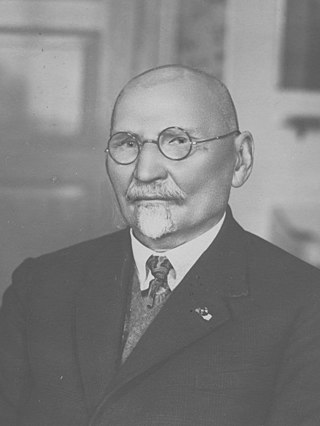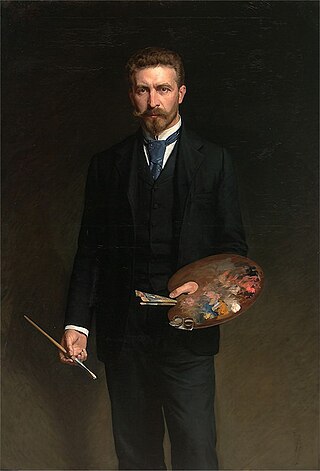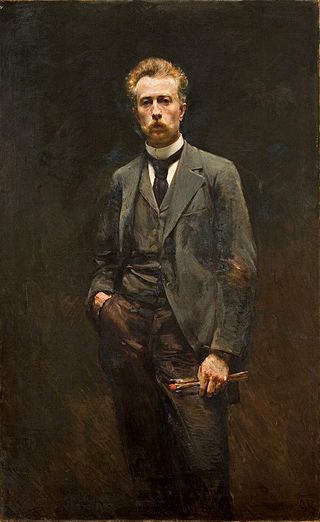This article needs additional citations for verification .(March 2016) |

Witold Pruszkowski (14 January 1846, Bershad - 10 October 1896, Budapest) was a Polish painter and graphic artist in the Symbolist style.
This article needs additional citations for verification .(March 2016) |

Witold Pruszkowski (14 January 1846, Bershad - 10 October 1896, Budapest) was a Polish painter and graphic artist in the Symbolist style.
He spent his childhood in Odessa and Kiev. The family emigrated to Dieppe in 1860, and he relocated to Paris in 1866, where he had his first drawing lessons with the portrait painter, Tadeusz Gorecki, the son-in-law of Adam Mickiewicz. From 1869 to 1872, he studied at the Academy of Fine Arts, Munich with Alexander von Wagner then, from 1872 to 1875, at the Kraków Academy of Fine Arts with Jan Matejko. [1]
In 1882, he settled in Mników. Over the next few years, he and his brother travelled to Algeria, Tunisia and Italy. He also held several exhibitions in Warsaw and Lwów. Later, he exhibited internationally, including shows in San Francisco and Chicago. [1] In 1892, he became a member of the construction committee for a monument to Artur Grottger.
He was ill for several years before his death. While visiting with family in Kołomyja, he suddenly disappeared. He was found at the train station in Budapest, suffering from extreme exhaustion, and was taken to a hospital, where he died two days later. [1]
Although he painted portraits and rural scenes, he is best known for his depictions of fairy tales and folklore; working in pastels as well as oils. He also drew inspiration from the works of Juliusz Słowacki and Zygmunt Krasiński. [1] His most familiar work is, perhaps, "March to Siberia", painted in 1893. Its whereabouts were unknown for many years, but it was found in a private collection after World War II and is now in the Lviv National Art Gallery.

Tadeusz Pruszkowski was a Polish painter and art teacher, known primarily for his portraits.

Jan Alojzy Matejko was a Polish painter, a leading 19th-century exponent of history painting, known for depicting nodal events from Polish history. His works include large scale oil paintings such as Rejtan (1866), the Union of Lublin (1869), the Astronomer Copernicus, or Conversations with God (1873), or the Battle of Grunwald (1878). He was the author of numerous portraits, a gallery of Polish monarchs in book form, and murals in St. Mary's Basilica, Kraków. He is considered by many as the most celebrated Polish painter, and sometimes as the "national painter" of Poland. Matejko was among the notable people to receive an unsolicited letter from the German philosopher Friedrich Nietzsche, as the latter tipped, in January 1889, into his psychotic breakdown while in Turin.

Leon Jan Wyczółkowski was one of the leading painters of the Young Poland movement, as well as the principal representative of Polish Realism in art of the Interbellum. From 1895 to 1911 he served as professor of the Jan Matejko Academy of Fine Arts (ASP) in Kraków, and from 1934, ASP in Warsaw. He was a founding member of the Society of Polish Artists "Sztuka".

Jacek Malczewski was a Polish symbolist painter who is one of the most revered painters of Poland, associated with the patriotic Young Poland movement following a century of Partitions. He is regarded as the father of Polish Symbolism. His creative output combined the predominant style of his times with historical motifs of Polish martyrdom, the romantic ideals of independence, Christian and Greek mythology, folk tales, as well as his love of the natural world. He was the father of painter Rafał Malczewski.

Henryk Hektor Siemiradzki was a Polish painter. He spent most of his active creative life in Rome. Best remembered for his monumental academic art. He was particularly known for his depictions of scenes from the ancient Greek-Roman world and the New Testament, owned by many national galleries of Europe.

Ignacy Aleksander Gierymski was a Polish painter of the late 19th century, the younger brother of Maksymilian Gierymski. He was a representative of Realism as well as an important precursor of Impressionism in Poland.

Jan Grzegorz Stanisławski was a Polish modernist painter, art educator, and founder and member of various innovative art groups and literary societies. In 1906 he became a full professor at the Academy of Fine Arts in Kraków.

Henryk Gotlib was a Polish painter, draughtsman, printmaker, and writer, who settled in England during World War II and made a significant contribution to modern British art. He was profoundly influenced by Rembrandt, and the European Expressionist painters. Gotlib was a leading member of the Polish avant-garde 'Formist' movement in the interwar Poland.

Roman Zakrzewski was a Polish painter. After beginning his artistic education in high school in Bielsko-Biała, he graduated from the Academy of Fine Arts in Cracow and in 1985 from Jerzy Nowosielski studio. He lived and worked in Kraków.

Anna Bilińska was a Polish painter, known for her portraits. A representative of realism, she spent most of her life in Paris, and is considered the "first internationally known Polish woman artist."

Aleksander Lesser was a Polish painter, illustrator, sketch artist, art critic, and amateur researcher of antiquities. Lesser was Jewish, and became one of the first artists to depict scenes from modern Jewish history in Poland. He specialized in Polish historical and contemporary themes, and he was known and respected in artistic and scholarly circles. He was a member of Kraków's Academy of Learning and co-founder of Warsaw's Zachęta, the Society for Encouragement of the Fine Arts.
Caziel was a Polish artist who lived and worked in Paris during the inter-war period and who worked alongside a number of important figures of the School of Paris, including Pablo Picasso and the art dealer Daniel-Henry Kahnweiler.

Leopold Loeffler, also spelled Löffler,, was a Polish realist painter of the late Romantic period popular in the second half of the 19th century under the foreign partitions of Poland. Lithographic reproductions of his paintings were widely distributed among the members of the Kraków and Warsaw art societies, and frequently reprinted in popular periodicals owing to their historical references to Polish national uprisings and battlefronts, as well as their great attention to period detail.
Bronisław Abramowicz (1837–1912) was a Polish painter, born in Załuchów.

Kazimierz Teofil Pochwalski was a Polish painter known primarily for his portraits, although he produced works in a wide variety of genres.
Zefiryn (Zefir) Alojzy Ćwikliński Ceferino - Polish painter, known primarily for painting in the Tatra mountains.

Aleksander Augustynowicz was a Polish painter, active between 1865 and 1944 in Poland.
Katarzyna Karpowicz is a Polish contemporary painter.

Maximilian (Maksymilian) Antoni Piotrowski (1813–1875) was a Polish painter and professor at the Academy of Fine Arts in Kaliningrad. Additionally, he was a Polish patriot who took part in the national uprisings of the time.

Margit Sielska-Reich was a Polish-Ukrainian painter who worked in Lviv.